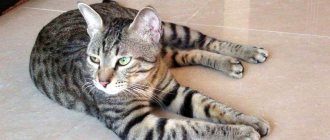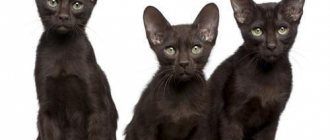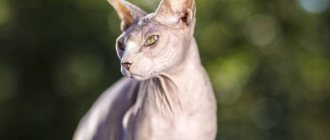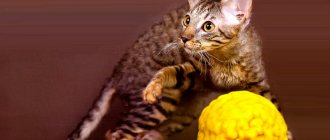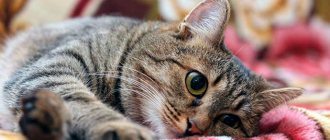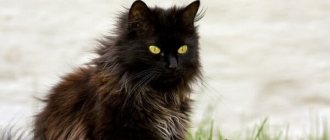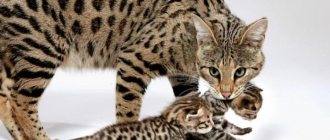History of the British Shorthair cat
British Shorthair Cat
Over the years, it is impossible to find documentary evidence of the first appearance of cats in the British Isles. However, researchers suggest that domesticated animals were brought there by Roman conquerors. The legionnaires, of course, did not keep them as furry friends - someone needed to protect the provisions in the holds from the attacks of ship rats. True, those rodent hunters bore little resemblance to today’s round-faced and well-built individuals; their physique was closer to the graceful and long-legged Egyptian animals.
But the free feline nature took its toll - and some of the small predators brought by the invaders moved from the decks to solid ground, and there, over time, they met wild relatives who enriched the gene pool.
For centuries, short-haired purrs lived side by side with peasants, receiving a little milk and a roof over their heads for their contribution to the fight against mice. No one, of course, cared about selecting kittens based on coat color, ear shape and tail length, so the appearance of the breed was formed naturally. It must be said that the attitude towards these cute creatures was often not just indifferent, but even hostile, while dogs were considered true friends, worthy of sugar bones and a place by the fireplace.
It was only in the second half of the 19th century that the British realized that their pets had many unique and attractive characteristics that needed to be strengthened and developed. In the Victorian era, being the owner of a cat became not shameful even for a representative of high society. The popularity of mustachios was greatly promoted by the original and witty drawings of the famous English artist Louis Wain. A talented graphic artist created a whole universe in which anthropomorphic cats play golf and bridge, go on picnics, read newspapers, have Christmas parties, sledding, play music, relax on the beach... In addition, already at the dawn of the development of photography, enthusiasts of the new art realized that how beautiful furry creatures look in the frame. In a word, the ice was broken.
British blue color (gray, classic), which is standard for the breed
British cat kitten
On July 13, 1871, the world's first professionally organized cat show was held in London with great success. Harrison Ware, with the support of the then manager of Crystal Palace, invited 170 event participants and their owners to the former World's Fair pavilion. He also developed competition regulations, a system for awarding points and determining winners in various categories. Visitors were surprised to discover that well-groomed and well-fed cats not only look charming, but also behave like real aristocrats. The next morning, the front pages of the capital's respected newspapers were adorned with portraits of the award winners, including 14-year-old blue tabby Old Lady. By the way, it was the blue color that was considered the only correct color for British shorthairs in the last century.
After the exhibition, the once unnoticed street animals gained popularity. A breed standard, amateur clubs and the first kennels appeared. However, in the last decade of the 19th century, Great Britain was swept by the pan-European fashion for Persian cats. On this wave, during the First World War, breeders introduced the British Longhair. Experts still cannot say with certainty whether a fixed spontaneous mutation took place or whether the breeders simply used “foreign” genes in breeding.
With the outbreak of World War II, the already unfavorable situation for shorthairs became truly catastrophic. Animals, like people, died en masse under German bombing, and the policy of food austerity left no chance of maintaining nurseries. In the post-war years, the few surviving British cats were actively crossed with representatives of various breeds to produce offspring: Russian Blue, Chartreux, Persian. Due to the large percentage of mixed blood, the breed was classified as a hybrid for a long time and therefore was not registered by leading regional and world felinological organizations. The American Cat Association distinguished American Shorthairs from Old World cats in 1967, listing the latter under the name "British Blue." The ACFA accepted the breed in 1970, and The Cat Fanciers' Association (CFA) recognized the breed in 1980.
British cat of smoky color
British color point cat
Personality of the British Shorthair cat
I love scratches!
The British cat is a rare example of complete correspondence between appearance and inner world. In character, these plush hulks truly resemble your favorite soft toys from your childhood. And the special “smiling” expression of their round faces once made them a real prototype of the Cheshire Cat from the stories about Alice’s adventures. Good-natured and unpretentious companions fit perfectly into the life of almost any family, without requiring absolute attention to their person.
However, the latter does not mean that they are indifferent to their owners. On the contrary, representatives of the breed are very attached to “their” people and often move with them from room to room, but do this unobtrusively. Fluffy intellectuals love affection, however, they prefer to receive it on their own terms - they will happily sit next to you on a soft sofa and will purr contentedly in response to stroking, but they will not be particularly enthusiastic about the idea of lying on your lap or being in a gentle embrace. Personal space for the subjects of the British Queen is not an empty phrase!
The cat will spend the time that household members spend at work or study not on organizing a pogrom in the home, but on peaceful sleep or contemplating the surroundings from a window with a wide windowsill. If some trinkets dear to your heart suffer from his paws, it will happen completely by accident. The fact is that short-haired cats are not very graceful. Their cute clumsiness is also quite consistent with the image of a clumsy bear cub.
Cat fight
Despite the fact that for a comfortable life, the British do not need to have a playmate, due to their easy-going and friendly nature, they have no problem letting other pets into their close social circle: cats, dogs of different breeds and sizes, reptiles and (despite strong hunting instincts) rodents, birds. They get along well with children - provided that the kids do not overdo it in showing affection or treat them rudely.
In addition, British will not cause misunderstandings with neighbors, even if the walls in the house are very thin. Of course, little kittens and teenagers love noisy games. But with the onset of maturity, in English they are reserved, sedate and silent.
However, British shorthair cats can from time to time surprise their owners with unexpected outbursts of activity, turning at such moments into carefree rogues, rushing around the house at great speed after a real ball or imaginary prey.
I am extremely dissatisfied!
I think they suit me better than you
Behavior of British cats
Animals sleep for a very long time, but do not be afraid of this. By nature they are very lazy. And this behavior of British cats often surprises inexperienced owners.
Only after a healthy, long sleep will the British be able to please their owners, play and find a good mood. It is better not to try to wake the animal. A sudden awakening will affect your cat's behavior and appetite.
The British are very clean and tidy. The fur of a British cat will never be dirty. They always take care of their appearance. Cats bathe several times a day for a long time. Self-care helps Brits relieve stress. Washing calms and relaxes animals.
A British cat will never try to attract attention to itself. Animals rarely meow to ask their owner for food. They will sit quietly at the bowl and wait until the person feeds them. A pet will figure everything out on its own and will never ask a person for help, even if it needs it.
Only a real owner's cats will purr. The British cat is not very affectionate. The cat does not like to be held and does not tolerate excessive affection. However, the owners of these animals should not forget about their pets, then the cats begin to get bored and sad.
Care and maintenance
British cats do not cause much trouble for their owners. Their dense and thick fur practically does not tangle or mat, so to care for the fur, it is enough to go through the fur coat with a special brush once or twice a week and remove fallen hairs. During periods of seasonal molting (spring and autumn), the procedure must be carried out more often, otherwise furniture and clothes will become unexpectedly fluffy.
Brushing a British kitten
Ears are cleaned once every two weeks, it is advisable to wipe eyes with cotton swabs soaked in boiled water once a week.
It makes sense to give your pet fur-dissolving medications from time to time, since when licking, some of the thick fur gets into the stomach and can cause serious health problems.
Frequent washing of a cat is undesirable, since the natural fat layer is a barrier to many infections and bacteria. If for any reason the animal is so dirty that washing cannot solve the problem, be sure to use gentle products recommended by veterinarians and make sure that water does not get into the ears - this can cause inflammation of the ear canal.
Time for yogurt
The immune system of the British allows them to take long walks outside without health consequences when the air temperature does not drop too low, but in large cities heavy traffic, dog attacks and the actions of intruders pose a serious danger, so keeping them at home would be preferable.
This breed is prone to obesity, which is the root cause of a number of diseases. Relatively low physical activity of adults leads to rapid accumulation of excess weight. A balanced diet and strict adherence to recommended serving sizes will help avoid problems. When eating natural foods, do not forget about the need to take vitamin and mineral supplements.
Regular preventative examinations at the veterinary clinic, timely vaccinations and regular dental and ear care will help ensure a good standard of living for your pet. Please note that all reputable breeding and cat owner organizations strongly oppose the practice of declawing and tendonectomy (a surgical procedure in which part of the tendon responsible for the claw release mechanism is removed). The most humane ways to protect your furniture and wallpaper is to carefully trim off the sharp ends and train them to use a scratching post.
Bad habits of British cats
Although this breed has aristocratic manners, they also have bad habits:
- These animals are very inquisitive. They are interested in looking and rummaging through the things in their bags. Therefore, you should not leave them in a visible place.
- They love to climb on shelves and throw everything out of there. Objects lying there in the form of cosmetics or standing vases will definitely end up on the floor. It is recommended to treat the shelves with a repellent spray, then the hooliganism will stop immediately.
- During the period of change of milk teeth, kittens begin to bite, which often develops into a habit. To prevent this from happening, the owner should invite the kitten to sharpen its teeth on a toy, and not on his own hands.
Be sure to read:
How long do Scottish fold cats live: what affects them, vulnerabilities, how to prolong life
To quickly get rid of bad habits, you need to establish the reason for their occurrence. This often happens due to lack of attention from the owner or simply boredom.
Health and disease of the British Shorthair cat
The health of the breed is not of serious concern to specialists. But breeders who claim that British Shorthairs are generally not prone to disease are shamelessly disingenuous. Yes, there are no diseases specific to the British cat, however, there are those to which any purebred cat is susceptible, including those caused by genetics, therefore, before allowing animals for breeding, appropriate medical studies must be carried out.
Neighbor Watching
Hypertrophic cardiomyopathy is a thickening of the wall of one of the ventricles (usually the left), which leads to cardiac arrhythmias, heart failure and death. When detected at an early stage and lifelong use of a whole complex of drugs, the development of the disease can be significantly slowed down. Animals with this diagnosis cannot participate in breeding.
Hemophilia B - reduced blood clotting, as a result of which any injury is fraught with serious blood loss or extensive internal hemorrhage. Inbreeding increases the risk of disease. There is no complete treatment; sick animals are given blood transfusions, and to combat anemia and stimulate hematopoiesis, iron supplements, hepatoprotectors, and vitamins B6 and B12 are prescribed. Gene carriers and individuals suffering from hemophilia are excluded from breeding.
What do you allow yourself!
Polycystic kidney disease is the formation of fluid-filled hollow tumors, which disrupts the normal functioning of the excretory system. A typical disease of Persian cats, with which the British suffered from hybridization. At the initial stages there are no noticeable changes in the pet’s behavior, so it is often diagnosed only in an advanced stage. There is no effective therapy. If the cysts are single, they can be removed during surgery, but in case of serious damage, only drug treatment is possible, which will prolong the animal’s life by several months or years.
Gingivitis is an inflammation of the gums that affects the ligaments and bones. Without proper treatment, tooth loss occurs and infection spreads through the bloodstream.
Diseases of British cats
Representatives of this breed, as a rule, get sick infrequently and have very good health, which ensures them a long life. The British cat's care requirements are standard: the cat must live clean and eat properly, it requires routine vaccinations and timely preventative visits to the veterinarian.
See how long British cats live with proper care.
The British have strong immunity, but do not tolerate cold well. A draft can cause colds, so the owner must carefully monitor the temperature of the home.
British kittens often have watery eyes in the first months of life. This is absolutely normal and the owner should know that this is not a sign of illness or disease. Veterinarians say that lacrimation stops in the first six months of life, so you shouldn’t bother your kitten with unnecessary treatment.
See also why a kitten's eyes are watery.
With proper care and a balanced diet, the British Shorthair can live next to a person for a very long time - up to 15 years.
How to choose a kitten
Let me in!
Like all purebred cats, real British Shorthairs are not sold in subway passages, at bird markets or through free advertisements on the Internet! The saddest consequence of such a “profitable” acquisition will not even be that the fluffy ball will grow into a cat completely different from the British one. As an inheritance from unknown parents, he can receive a whole bunch of congenital diseases, and the lack of veterinary support and non-compliance with the nutritional rules of a nursing mother and babies is the cause of poor immunity and acquired diseases.
You need to devote enough time to choosing a cattery, because only breeders who value their professional reputation, provide complete and reliable information about the pedigree, and care about the well-being of the cat and her kittens. Even if your goal is not a show-class British breed, pay attention to the success of “graduates” at regional and international shows - this is a good indication of healthy genetic lines.
A responsible breeder does not hand over kittens to buyers that are under 12-16 weeks of age. Until this time, you can reserve the baby you like, but he needs socialization in the company of brothers and sisters, learning the intricacies of cat life from his mother and, of course, timely vaccination, which will provide protection against many dangerous diseases.
The little Briton should be active and playful, have a good appetite and react to human society without fear.
Care
In terms of grooming, the British are not as demanding as they might seem.
There are just a few simple rules of care that will ensure your pet good health, long life and good mood:
- You need to play with your pet often. Like any other cat, the British cat will not disdain the “mouse” and round toys. The main thing is that the toy should rustle and crunch, attracting the pet’s attention.
- Particular attention should be paid to the claws. The British need at least a post for turning. It is possible to trim the claws, but it is not easy, so you should approach this procedure very carefully: only the sharp white tip is trimmed.
- All food must be placed in separate containers, otherwise the cat will not eat.
- Wool. To keep your pet's fur in shape, you will need a relatively large arsenal of brushes, combs and other special devices, which, however, can be purchased at any pet store. The greatest attention should be paid to the condition of the coat during the molting period.
Popular kennels for this breed:
- Russia - (your nursery is here);
- Belarus - (take place);
- Ukraine - (submit an application).
Photos of British kittens
How much does a British Shorthair cat cost?
The price of a kitten traditionally depends on the fame of the nursery, title status of the parents and compliance with breed standards.
But in the case of British Shorthairs, color also matters. The most common blue and chocolate with copper-yellow eyes are also the most affordable in their class. But unusual individuals, for example, a blue-eyed color-point or a chinchilla with emerald eyes will cost much more. The British, who are suitable for life in a loving family, but do not have the makings of a future champion or qualities interesting for breeding, can become yours for 3-10 thousand rubles. Further, the price increases depending on pedigree and personal prospects. The cost of show-class kittens reaches 35-50 thousand rubles.

